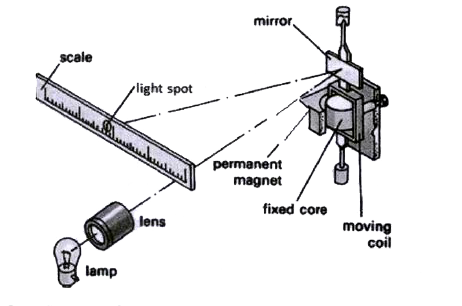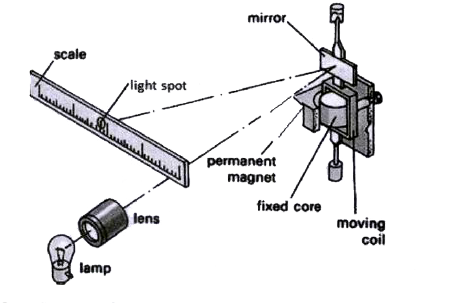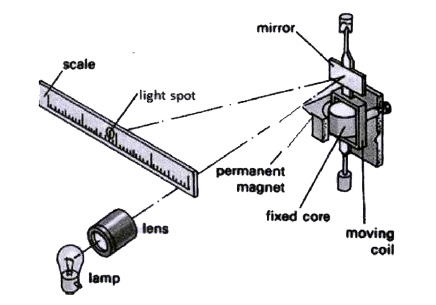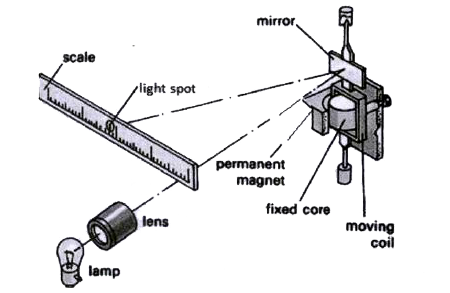Richard's project on the purpose of the twelve tiny gold spots on a monarch pupa was highly.
Richard Ebright began the research as the purpose of the twelve tiny gold spoils on a reach papa Everyone assumed that the spoils were just anomaly But Dr. Urquhart didn.t believe it. So Richard along with her excellent science students bill a device ! show that the spots were producing a hormone necessary for the development of a bitterly. This result was highly valuable as he was able to identify the hormone.s chemical structure and lakes got the idea about cell life. It gave answer to one of biology.s of its DNA. The theory was a big step towards understanding the processes of life. It might also lead to new ideas for preventing same types of cancer and other diseases.
Similar Questions
II. Read the following text and answer the following questions on the basis of the same:
Galvanometer can sense/measure current. Improved mirror galvanometer was developed by William Thomson, later to become Lord Kelvin, in 1858. Thomson intended the instrument to read weak signal currents on very long submarine telegraph cables.
The fundamental problems of transmitting/receiving a singnal through a lengthy submarine cable was that the electrical current tended to be very low (as littles as 1/100,000th of a stadard light bulb). So, it was very difficult to detect it. To solve the problem it was thought that larger amount of electric current would be sent through the line. But Thomson had a different approach. He thought the best response was to devise a device that could read faint signals. The galvanometer, first invented in 1802, was a mean of detecting electric current. It consisted of a needle that was deflected by the magnetic field created by the electric current. But the galvanometers of the day could't detect the weak signals that came through a long underwater cable. But the improved version of galvanometer was highly sensitive to detect the lowest current. The mirror galvanometer consists of a long fine coil of silk-covered copper wire. In the heart of that coil, within a little air-chamber, a small round mirror is hung by a single fibre of floss silk, with four tiny magnets cemented to its back.
A beam of light is thrown from a lamp upon the mirror, and reflected by it upon a white screen or scale a few feet distant, where it forms a bright spot of light, when there is no current on the instrument, the spot of light remains stationary at the zero position on the screen, but the instant a current traverses the long wire of the coil, the suspended magnets twist themselves horizontally out of their former position, the mirror is inclined with them, and the beam of light is deflected along the screen to one side or the other, according to the nature of the current. If positive electric current gives a deflection to the right of zero, a negative current will give a deflection to the left of zero, and vice versa.
The air in the little chamber surrounding the mirror is compressed, so as to act like a cushion, and deaden the movements of the mirror, the mirror is thus prevented from idly swinging about at each deflections.
Mirror galvanometer galvabometer was primarily used to

View SolutionII. Read the following text and answer the following questions on the basis of the same:
Galvanometer can sense/measure current. Improved mirror galvanometer was developed by William Thomson, later to become Lord Kelvin, in 1858. Thomson intended the instrument to read weak signal currents on very long submarine telegraph cables.
The fundamental problems of transmitting/receiving a singnal through a lengthy submarine cable was that the electrical current tended to be very low (as littles as 1/100,000th of a stadard light bulb). So, it was very difficult to detect it. To solve the problem it was thought that larger amount of electric current would be sent through the line. But Thomson had a different approach. He thought the best response was to devise a device that could read faint signals. The galvanometer, first invented in 1802, was a mean of detecting electric current. It consisted of a needle that was deflected by the magnetic field created by the electric current. But the galvanometers of the day could't detect the weak signals that came through a long underwater cable. But the improved version of galvanometer was highly sensitive to detect the lowest current. The mirror galvanometer consists of a long fine coil of silk-covered copper wire. In the heart of that coil, within a little air-chamber, a small round mirror is hung by a single fibre of floss silk, with four tiny magnets cemented to its back.
A beam of light is thrown from a lamp upon the mirror, and reflected by it upon a white screen or scale a few feet distant, where it forms a bright spot of light, when there is no current on the instrument, the spot of light remains stationary at the zero position on the screen, but the instant a current traverses the long wire of the coil, the suspended magnets twist themselves horizontally out of their former position, the mirror is inclined with them, and the beam of light is deflected along the screen to one side or the other, according to the nature of the current. If positive electric current gives a deflection to the right of zero, a negative current will give a deflection to the left of zero, and vice versa.
The air in the little chamber surrounding the mirror is compressed, so as to act like a cushion, and deaden the movements of the mirror, the mirror is thus prevented from idly swinging about at each deflections.
The basic principle of gavanometer is

View Solution
Knowledge Check
II. Read the following text and answer the following questions on the basis of the same:
Galvanometer can sense/measure current. Improved mirror galvanometer was developed by William Thomson, later to become Lord Kelvin, in 1858. Thomson intended the instrument to read weak signal currents on very long submarine telegraph cables.
The fundamental problems of transmitting/receiving a singnal through a lengthy submarine cable was that the electrical current tended to be very low (as littles as 1/100,000th of a stadard light bulb). So, it was very difficult to detect it. To solve the problem it was thought that larger amount of electric current would be sent through the line. But Thomson had a different approach. He thought the best response was to devise a device that could read faint signals. The galvanometer, first invented in 1802, was a mean of detecting electric current. It consisted of a needle that was deflected by the magnetic field created by the electric current. But the galvanometers of the day could't detect the weak signals that came through a long underwater cable. But the improved version of galvanometer was highly sensitive to detect the lowest current. The mirror galvanometer consists of a long fine coil of silk-covered copper wire. In the heart of that coil, within a little air-chamber, a small round mirror is hung by a single fibre of floss silk, with four tiny magnets cemented to its back.
A beam of light is thrown from a lamp upon the mirror, and reflected by it upon a white screen or scale a few feet distant, where it forms a bright spot of light, when there is no current on the instrument, the spot of light remains stationary at the zero position on the screen, but the instant a current traverses the long wire of the coil, the suspended magnets twist themselves horizontally out of their former position, the mirror is inclined with them, and the beam of light is deflected along the screen to one side or the other, according to the nature of the current. If positive electric current gives a deflection to the right of zero, a negative current will give a deflection to the left of zero, and vice versa.
The air in the little chamber surrounding the mirror is compressed, so as to act like a cushion, and deaden the movements of the mirror, the mirror is thus prevented from idly swinging about at each deflections.
Improved mirror galvanometer was developed by
 ALord KelvinBJohann SchweiggerCLuigi GalvaniDAndre-Marie Ampere
ALord KelvinBJohann SchweiggerCLuigi GalvaniDAndre-Marie AmpereII. Read the following text and answer the following questions on the basis of the same:
Galvanometer can sense/measure current. Improved mirror galvanometer was developed by William Thomson, later to become Lord Kelvin, in 1858. Thomson intended the instrument to read weak signal currents on very long submarine telegraph cables.
The fundamental problems of transmitting/receiving a singnal through a lengthy submarine cable was that the electrical current tended to be very low (as littles as 1/100,000th of a stadard light bulb). So, it was very difficult to detect it. To solve the problem it was thought that larger amount of electric current would be sent through the line. But Thomson had a different approach. He thought the best response was to devise a device that could read faint signals. The galvanometer, first invented in 1802, was a mean of detecting electric current. It consisted of a needle that was deflected by the magnetic field created by the electric current. But the galvanometers of the day could't detect the weak signals that came through a long underwater cable. But the improved version of galvanometer was highly sensitive to detect the lowest current. The mirror galvanometer consists of a long fine coil of silk-covered copper wire. In the heart of that coil, within a little air-chamber, a small round mirror is hung by a single fibre of floss silk, with four tiny magnets cemented to its back.
A beam of light is thrown from a lamp upon the mirror, and reflected by it upon a white screen or scale a few feet distant, where it forms a bright spot of light, when there is no current on the instrument, the spot of light remains stationary at the zero position on the screen, but the instant a current traverses the long wire of the coil, the suspended magnets twist themselves horizontally out of their former position, the mirror is inclined with them, and the beam of light is deflected along the screen to one side or the other, according to the nature of the current. If positive electric current gives a deflection to the right of zero, a negative current will give a deflection to the left of zero, and vice versa.
The air in the little chamber surrounding the mirror is compressed, so as to act like a cushion, and deaden the movements of the mirror, the mirror is thus prevented from idly swinging about at each deflections.
How the idly swinging of the mirror of mirror galvanometer is prevented?
 AThe little chamber surrounding the mirror was filled with a viscous liquidBThe mirror was placed in little chamber which was completely vacuumCThe mirror was attached to a springDThe little chamber surrounding the mirror was filled with compressed air
AThe little chamber surrounding the mirror was filled with a viscous liquidBThe mirror was placed in little chamber which was completely vacuumCThe mirror was attached to a springDThe little chamber surrounding the mirror was filled with compressed airII. Read the following text and answer the following questions on the basis of the same:
Galvanometer can sense/measure current. Improved mirror galvanometer was developed by William Thomson, later to become Lord Kelvin, in 1858. Thomson intended the instrument to read weak signal currents on very long submarine telegraph cables.
The fundamental problems of transmitting/receiving a singnal through a lengthy submarine cable was that the electrical current tended to be very low (as littles as 1/100,000th of a stadard light bulb). So, it was very difficult to detect it. To solve the problem it was thought that larger amount of electric current would be sent through the line. But Thomson had a different approach. He thought the best response was to devise a device that could read faint signals. The galvanometer, first invented in 1802, was a mean of detecting electric current. It consisted of a needle that was deflected by the magnetic field created by the electric current. But the galvanometers of the day could't detect the weak signals that came through a long underwater cable. But the improved version of galvanometer was highly sensitive to detect the lowest current. The mirror galvanometer consists of a long fine coil of silk-covered copper wire. In the heart of that coil, within a little air-chamber, a small round mirror is hung by a single fibre of floss silk, with four tiny magnets cemented to its back.
A beam of light is thrown from a lamp upon the mirror, and reflected by it upon a white screen or scale a few feet distant, where it forms a bright spot of light, when there is no current on the instrument, the spot of light remains stationary at the zero position on the screen, but the instant a current traverses the long wire of the coil, the suspended magnets twist themselves horizontally out of their former position, the mirror is inclined with them, and the beam of light is deflected along the screen to one side or the other, according to the nature of the current. If positive electric current gives a deflection to the right of zero, a negative current will give a deflection to the left of zero, and vice versa.
The air in the little chamber surrounding the mirror is compressed, so as to act like a cushion, and deaden the movements of the mirror, the mirror is thus prevented from idly swinging about at each deflections.
The mirror galvanometer consists of
 Aa small round mirror attached to a fine coil of silk-covered copper wire.Ba long fine coil of silk-covered copper wire and a small round mirror hung by a single fibre of floss silk, with four thiny magnets cemented to its back.Ca small round mirror attached to four tiny magnets.DNone of the above
Aa small round mirror attached to a fine coil of silk-covered copper wire.Ba long fine coil of silk-covered copper wire and a small round mirror hung by a single fibre of floss silk, with four thiny magnets cemented to its back.Ca small round mirror attached to four tiny magnets.DNone of the above
